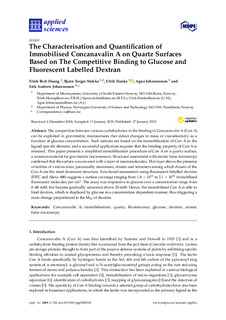| dc.contributor.author | Hoang, Trinh Bich | |
| dc.contributor.author | Stokke, Bjørn Torger | |
| dc.contributor.author | Hanke, Ulrik | |
| dc.contributor.author | Johannessen, Agne | |
| dc.contributor.author | Johannessen, Erik Andrew | |
| dc.date.accessioned | 2019-09-24T06:40:44Z | |
| dc.date.available | 2019-09-24T06:40:44Z | |
| dc.date.created | 2019-02-14T10:49:15Z | |
| dc.date.issued | 2019 | |
| dc.identifier.citation | Applied Sciences. 2019, 9 (2), 1-16. | nb_NO |
| dc.identifier.issn | 2076-3417 | |
| dc.identifier.uri | http://hdl.handle.net/11250/2618335 | |
| dc.description.abstract | The competition between various carbohydrates in the binding to Concanavalin A (Con A) can be exploited in gravimetric microsensors that detect changes in mass or viscoelasticity as a function of glucose concentration. Such sensors are based on the immobilisation of Con A as the ligand specific element, and a successful application requires that the binding property of Con A is retained. This paper presents a simplified immobilisation procedure of Con A on a quartz surface, a common material for gravimetric microsensors. Structural assessment with atomic force microscopy confirmed that the surface was covered with a layer of macromolecules. This layer shows the presence of entities of various sizes, presumably monomers, dimers and tetramers among which dimers of the Con A are the most dominant structure. Functional assessment using fluorescent labelled dextran (FITC and Alexa 488) suggests a surface coverage ranging from 1.8 × 1011 to 2.1 × 1012 immobilised fluorescent molecules per cm2. The assay was responsive to glucose over a concentration range from 0–40 mM, but became gradually saturated above 20 mM. Hence, the immobilised Con A is able to bind dextran, which is displaced by glucose in a concentration dependent manner, thus triggering a mass change proportional to the MW of dextran. | nb_NO |
| dc.language.iso | eng | nb_NO |
| dc.publisher | MDPI | nb_NO |
| dc.rights | Navngivelse 4.0 Internasjonal | * |
| dc.rights.uri | http://creativecommons.org/licenses/by/4.0/deed.no | * |
| dc.title | The Characterisation and Quantification of Immobilised Concanavalin A on Quartz Surfaces Based on The Competitive Binding to Glucose and Fluorescent Labelled Dextran | nb_NO |
| dc.type | Journal article | nb_NO |
| dc.type | Peer reviewed | nb_NO |
| dc.description.version | publishedVersion | nb_NO |
| dc.source.pagenumber | 1-16 | nb_NO |
| dc.source.volume | 9 | nb_NO |
| dc.source.journal | Applied Sciences | nb_NO |
| dc.source.issue | 2 | nb_NO |
| dc.identifier.doi | 10.3390/app9020318 | |
| dc.identifier.cristin | 1677303 | |
| dc.description.localcode | © 2019 by the authors. Licensee MDPI, Basel, Switzerland. This article is an open access article distributed under the terms and conditions of the Creative Commons Attribution (CC BY) license (http://creativecommons.org/licenses/by/4.0/). | nb_NO |
| cristin.unitcode | 194,66,20,0 | |
| cristin.unitname | Institutt for fysikk | |
| cristin.ispublished | true | |
| cristin.fulltext | original | |
| cristin.qualitycode | 1 | |

